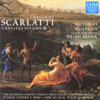A. Scarlatti Cantatas, Volume 3
View record and artist detailsRecord and Artist Details
Composer or Director: (Pietro) Alessandro (Gaspare) Scarlatti
Label: DHM
Magazine Review Date: 5/2000
Media Format: CD or Download
Media Runtime: 64
Mastering:
DDD
Catalogue Number: 75605 51325-2

Tracks:
| Composition | Artist Credit |
|---|---|
| Nel silenzio comune |
(Pietro) Alessandro (Gaspare) Scarlatti, Composer
(Pietro) Alessandro (Gaspare) Scarlatti, Composer Arcadian Academy Brian Asawa, Alto Nicholas McGegan, Harpsichord |
| Fermate, omai fermate |
(Pietro) Alessandro (Gaspare) Scarlatti, Composer
(Pietro) Alessandro (Gaspare) Scarlatti, Composer Arcadian Academy Brian Asawa, Alto Nicholas McGegan, Harpsichord |
| Clori vezzosa e bella |
(Pietro) Alessandro (Gaspare) Scarlatti, Composer
(Pietro) Alessandro (Gaspare) Scarlatti, Composer Arcadian Academy Brian Asawa, Alto Nicholas McGegan, Harpsichord |
| Piango, sospiro, e peno |
(Pietro) Alessandro (Gaspare) Scarlatti, Composer
(Pietro) Alessandro (Gaspare) Scarlatti, Composer Arcadian Academy Brian Asawa, Alto Nicholas McGegan, Harpsichord |
| Non sò qual più m'ingombra |
(Pietro) Alessandro (Gaspare) Scarlatti, Composer
(Pietro) Alessandro (Gaspare) Scarlatti, Composer Arcadian Academy Brian Asawa, Alto Nicholas McGegan, Harpsichord |
Author: Lionel Salter
It has been a longish wait since the delectable first volume (6/97) of this series; but it is good news that Vol. 3 is already in the pipeline. Like the previous disc, this one features a single singer – the American countertenor who has made a name for himself in Handel’s Theodora. His is a fine, firmly produced voice, even throughout its range; both his intonation and his enunciation are impeccable; he is exact in his handling of florid passages; and his ornamentations (see mingly spontaneous) are very stylish. If I have one reservation, it is that for too much of the time (except in Infirmata, vulnerata) he sings at one constant level of dynamics – though he produces an arresting messa di voce on the first word of Ombre tacite. It is possible that the recording contributes to this: it is certainly responsible for the harpsichord sounding much weaker in some cantatas than in others.
By far the most substantial work here is the earliest, Perche tacete, probably dating from the mid-1690s. It is the only one with a Venetian opera-type overture (three movements, the outer ones with Corellian suspensions, enclosing an intermittent fugato), and the numerous movements include four arias, three of which are of two strophes. At the other extreme is Il rosignolo, scored only for continuo and consisting of just two da capo arias joined by a recitative: the nightingale’s song, it emerges, is a lament for love. Love is also the subject of O pace del mio cor (the lover vainly seeking peace of mind) and the 1716 Ombre tacite (the most fully scored of the present works), the despairing lament of a deceived lover. In the recitatives of both of these, Scarlatti underlines emotive words with extraordinary harmonic progressions. A contrast to all of these is provided by Il genio di Mitilde (for continuo alone), where the flightiness and capricious moods of the loved ones are reflected in an ultra-busy, athletic cello part. The one remaining work is something of an enigma: though in Latin and printed as a “sacred concerto”, the words could be interpreted as referring either to divine love or to human (which is presumably why McGegan includes it here). The style is certainly plainer than in the others except for the vigorous ending: there are chromatic harmonies in the first aria, and a later aria is unusual in being constructed on a seven-bar ground bass. The disc as a whole once again demonstrates Scarlatti’s range of styles and the diversity of his scoring (even within a single work).'
By far the most substantial work here is the earliest, Perche tacete, probably dating from the mid-1690s. It is the only one with a Venetian opera-type overture (three movements, the outer ones with Corellian suspensions, enclosing an intermittent fugato), and the numerous movements include four arias, three of which are of two strophes. At the other extreme is Il rosignolo, scored only for continuo and consisting of just two da capo arias joined by a recitative: the nightingale’s song, it emerges, is a lament for love. Love is also the subject of O pace del mio cor (the lover vainly seeking peace of mind) and the 1716 Ombre tacite (the most fully scored of the present works), the despairing lament of a deceived lover. In the recitatives of both of these, Scarlatti underlines emotive words with extraordinary harmonic progressions. A contrast to all of these is provided by Il genio di Mitilde (for continuo alone), where the flightiness and capricious moods of the loved ones are reflected in an ultra-busy, athletic cello part. The one remaining work is something of an enigma: though in Latin and printed as a “sacred concerto”, the words could be interpreted as referring either to divine love or to human (which is presumably why McGegan includes it here). The style is certainly plainer than in the others except for the vigorous ending: there are chromatic harmonies in the first aria, and a later aria is unusual in being constructed on a seven-bar ground bass. The disc as a whole once again demonstrates Scarlatti’s range of styles and the diversity of his scoring (even within a single work).'
Discover the world's largest classical music catalogue with Presto Music.

Gramophone Digital Club
- Digital Edition
- Digital Archive
- Reviews Database
- Full website access
From £8.75 / month
Subscribe
Gramophone Full Club
- Print Edition
- Digital Edition
- Digital Archive
- Reviews Database
- Full website access
From £11.00 / month
Subscribe
If you are a library, university or other organisation that would be interested in an institutional subscription to Gramophone please click here for further information.




